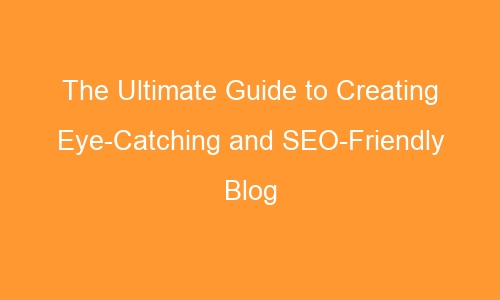Introduction
As a blogger, you want your posts to stand out and attract as many readers as possible. One way to achieve this is by creating eye-catching and SEO-friendly blog post titles. This can be tricky, as you want to capture your audience’s attention while also ensuring that your posts rank high in search engine results. In this Ultimate Guide to Creating Eye-Catching and SEO-Friendly Blog Post Titles, we will cover everything you need to know to create titles that are both captivating and optimized for search engines.
1. Start with a clear understanding of your target audience
When creating titles, it’s essential to have a clear understanding of who your target audience is. This will help you tailor your titles to their interests and concerns. Consider demographic factors such as age, gender, and location, as well as other factors such as interests, needs, and pain points. By understanding your audience, you can create titles that speak directly to them and catch their attention.
2. Use numbers and stats
Including numbers and stats in your titles can help make them more compelling. Numbers and stats provide concrete information, which can be more convincing than general claims or assertions. For example, you could write “10 Ways to Increase Your Blog Traffic” or “5 Benefits of Meditation for Mental Health.” Numbers can make your titles more memorable and can also help with search engine optimization.
3. Use powerful adjectives
Using powerful adjectives in your titles can help make them more eye-catching. Adjectives that convey emotions such as “amazing,” “incredible,” and “life-changing” can be particularly effective. For example, you could write “10 Amazing Travel Destinations You Must Visit” or “5 Incredible Recipes for Hassle-Free Dinners.” However, make sure that the adjectives you use accurately reflect the content of your post.
4. Use questions and teasers
Using questions and teasers in your titles can help create a sense of curiosity and anticipation. For example, you could write “What You Need to Know About Investing in Cryptocurrency” or “The Surprising Benefits of Practicing Gratitude.” Questions and teasers can be effective in catching readers’ attention and encouraging them to read on.
5. Keep it concise
Keeping your titles concise is important for both readability and search engine optimization. The ideal title length for search engine optimization is around 60 characters or less. However, you also want your title to be descriptive enough to give readers an idea of what your post is about. Aim for clear, concise titles that accurately reflect the content of your post.
6. Use long-tail keywords
Long-tail keywords are longer, more specific phrases that people may use when searching for content on a particular topic. Including long-tail keywords in your titles can help your posts rank higher in search engine results. Think about the specific phrases your target audience might use when searching for content related to your post and include them in your titles.
7. Analyze your competition
Analyzing your competition can provide valuable insights into what types of titles are working in your niche. Look at the titles of your competitors’ most popular posts and consider how you can adapt them to your own content. However, make sure that your titles are original and unique, as copying other titles can harm your credibility.
8. Experiment and test
Creating effective titles can be a trial and error process. Experiment with different techniques and strategies and track how they affect your readership and search engine rankings. Use analytics tools to monitor your performance and adjust your tactics accordingly.
FAQs
1. What are long-tail keywords, and why are they important for blog post titles?
Long-tail keywords are longer, more specific phrases that people may use when searching for content on a particular topic. Including long-tail keywords in your blog post titles can help your posts rank higher in search engine results, as they are less competitive and more targeted.
2. Should I include my keyword at the beginning of my title?
While including your keyword at the beginning of your title can be effective for search engine optimization, it’s not always necessary. The most important thing is to create a title that accurately reflects the content of your post and is compelling to readers.
3. How many words should my blog post title be?
For search engine optimization, it’s ideal to keep your title around 60 characters or less. However, you also want your title to be descriptive enough to give readers an idea of what your post is about. Aim for clear, concise titles that accurately reflect the content of your post.
4. Can I use the same title for multiple blog posts?
Ideally, you should create unique titles for each of your blog posts. Using the same title for multiple posts can make it difficult for search engines to distinguish between them and can also harm your credibility with readers.
5. Can I use clickbait titles for my blog posts?
While clickbait titles can be effective in attracting readers, they can also harm your credibility and lead to fewer returning visitors. It’s important to create titles that accurately reflect the content of your post and provide value to your readers.
6. Should I use questions in my blog post titles?
Using questions in your blog post titles can be effective in creating a sense of curiosity and anticipation. However, make sure that the questions are relevant to your target audience and accurately reflect the content of your post.
7. What is the best way to test and experiment with different blog post titles?
Using analytics tools can help you track the performance of your blog post titles and adjust your tactics accordingly. You can also try using different variations of a title and monitor which ones perform best in terms of readership and search engine rankings.
Conclusion
Creating eye-catching and SEO-friendly blog post titles requires a combination of creativity and strategic thinking. By understanding your target audience, using powerful adjectives, and incorporating long-tail keywords, you can create titles that are both compelling and optimized for search engines. Remember to test and experiment with different techniques and track your results. Ultimately, the goal is to create titles that accurately reflect the content of your post and provide value to your readers. So, go ahead, get creative, and start crafting those captivating titles! And don’t forget to hit that publish button and let the world know about your masterpiece.

